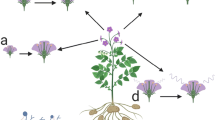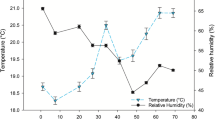Summary
We examined how mycorrhizal infection byGlomus etunicatum Becker and Gerd. affected flowering phenology and components of reproduction in eight wild accessions and two cultivars ofLycopersicon esculentum Mill. We did this by performing a detailed demographic study of flower, fruit and seed production. Mycorrhizal infection had variable effects on the ten accessions. Infection significantly decreased the time taken to initiate flowering in some accessions. In addition, infection increased flowering duration in some accessions. In many accessions, infection significantly increased seed production, primarily by increasing the number of inflorescences and infructescences. In some accessions, mycorrhizal infection also increased the proportion of flowers that produced mature fruits or the number of seeds per fruit. Among accessions, shoot phosphorus content was correlated with seed productivity for both mycorrhizal and non-mycorrhizal plants. However, non-mycorrhizal plants produced more seed biomass per mg of shoot phosphorus than mycorrhizal plants.
Similar content being viewed by others
References
Aker CL (1982) Regulation of flower, fruit and seed production by a monocarpic perennial,Yucca whipplei. J Ecol 70:357–372
Allen EB, Allen MF (1986) Water relations of xeric grasses in the field: interactions of mycorrhizas and competition. New Phytol 104:559–571
Augsperger CK (1981) Reproductive synchrony of a tropical shrub: experimental studies on effects of pollinators and seed predators onHybanthus prunifolius (Violaceae). Ecology 62:775–788
Bullock SH, Bawa KS (1981) Sexual dimorphism and the annual flowering pattern inJacaratia dolichaula (D. Smith) Woodson (Caricaceae) in Costa Rican rain forest. Ecology 62:1494–1504
Cooper KM (1984) Physiology of VA mycorrhizal associations. In: Powell CL, Bagyaraj DJ (eds) VA Mycorrhiza. CRC Press, Boca Raton, FL, USA
Dane F, Melton B (1973) Effect of temperature on self- and cross-compatibility and in vitro pollen growth characteristics in alfalfa. Crop Sci 13:587–591
Davis MA (1981) The effect of pollinators, predators and energy constraints on the floral ecology and evolution ofTrillium erectum. Oecologia 48:400–406
Denholm JV (1975) Necessary condition for maximum yield in a senescing two-phase plant. J Theor Biol 52:251–254
Dodd J, Krikun J, Haas J (1983) Relative effectiveness of indigenous populations of vesicular-arbuscular mycorrhizal fungi from four sites in Negev. Israel J Bot 32:10–21
Garwood NC, Horvitz CV (1985) Factors limiting fruit and seed production of a temperate shrub,Staphylea trifolia L. (Staphylaceae). Am J Bot 72:453–466
Gorchov DL (1988) Effects of pollen and resources on seed number and other fitness components inAmelanchier arborea (Rosaceae: Maloideae). Am J Bot 75:1275–1285
Gross RS, Werner PA (1982) Relationships among flowering phenology, insect visitors, and seed set: experimental studies on four co-occuring species of goldenrod (Solidago: Compositae). Ecol Monogr 53:95–117
Harper JL, Lovell RH, Moore KG (1970) The shapes and sizes of seeds. Ann Rev Ecol Syst 1:327–356
Hart R (1977) Why are biennials so few? Am Nat 111:792–797
Hayman DS (1983) The physiology of vesicular-arbuscular endomycorrhizal symbiosis. Can J Bot 61:944–963
Jackson DI, Sweet GB (1972) Flower initiation in temperate woody plants. Hort Abstr 49:9–24
Jeffries (1987) Use of mycorrhizae in agriculture. CRC Critical Rev Biotech 5:319–357
Jensen A (1982) Influence of four vesicular-arbuscular mycorrhizal fungi on nutrient uptake and growth in barley (Hordeum vulgare). New Phytol 90:45–50
Jensen A (1983) The effect of indigenous vesicular-arbuscular mycorrhizal fungi on nutrient uptake and growth of barley in two Danish soils. Plant Soil 70:155–163
King D, Roughgarden J (1982) Multiple switches between vegetative and reproductive growth in annual plants. Theor Pop Biol 21:194–204
Kinet J, Sachs RM, Bernier G (1985) The Physiology of Flowering. Volume III. The Development of Flowers. CRC Press, Inc., Boca Raton, FL, USA
Koide RT (1985) The nature of growth depressions in sunflower caused by vesicular-arbuscular mycorrhizal infection. New Phytol 99:449–462
Koide RT, Li M (1989) Appropriate controls for vesicular-arbuscular mycorrhizal research. New Phytol 111:35–44
Koide RT, Mooney HA (1987) Spatial variation in inoculum potential of vesicular-arbuscular mycorrhizal fungi caused by formation of gopher mounds. New Phytol 107:173–182
Koide RT, Li M, Lewis J, Irby C (1988) Role of mycorrhizal infection in the growth and reproduction of wild vs. cultivated plants. I. Wild vs. cultivated oats. Oecologia 77:537–543
Lee TD, Bazzaz FA (1982) Regulation of fruit maturation pattern in annual legume,Cassia fasciculata. Ecology 63:1374–1388
Lloyd DG (1980) Sexual strategies in plants. I. An hypothesis of maternal investment during one reproductive session. New Phytol 86:69–79
Machlis L, Torrey JG (1956) Plants in Action. Freeman, San Francisco
Mack RN, Harper JL (1977) Interference in dune annuals: spatial pattern and neighborhood effects. J Ecol 65:345–363
Menary RC, Van Staden J (1976) Effect of phosphorus nutrition and cytokinins on flowering in tomato,Lycopersicon esculentum Mill. Aust J P1 Phys 3:201–205
Mosse B (1873) Advances in the study of vesicular-arbuscular mycorrhiza. Ann Rev Phytopath 11:171–196
Motten AF (1982) Autogomy and competition for pollinators inHepatica americana (Ranunculaceae). Am J Bot 69:1296–1305
Motten AF, Campbell DR, Alexander DE, Miller HL (1981) Pollination effectiveness of specialits visitors to a North Carolina population ofClaytonia virginica. Ecology 62:1278–1287
Parrish JAD, Bazzaz FA (1985) Nutrient content ofAbutilon theophrasti seeds an the competitive ability of the resulting plants. Oecologia 65:247–251
Patton DC, Ford HA (1983) The influence of plant characters and honeyeater size on levels of pollination in Australian plants. In: Jones CE and Little RJ (eds), Handbook of Experimental Pollination Biology. Van Nostrand Reinhold, New York, USA, pp 235–248
Primack RB (1978) Regulation of seed yield inPlantago. J Ecol 66:835–847
Primack RB (1980) Variation in phenology of natural populations of montane shrubs in New Zealand. J Ecol 68:849–862
Rovira AD, Bowen GD (1966) The effects of microorganisms upon plant growth. II. Detoxification of heat sterilized soils by fungi and bacteria. Plant Soil 25:129–141
Schaffer WH, Schaffer MV (1979) The adaptive significance of variations in reproductive habit in the Agavaceae. II. Pollinator foraging behavior and selection for increased reproductive expenditure. Ecology 60:1051–1069
Schemske DW (1977) Flowering phenology and seed set inClaytonia virginica (Portulaceae). Bull Torr Bot Cl 104:253–263
Schemske DW (1980a) Evolution of floral display in the orchidBrassavola nodosa. Evolution 34:489–493
Schemske DW (1980b) Floral ecology and hummingbird pollination ofCombretum farinosum in Costa Rica. Biotropica 12:169–181
Schemske DW, Wilson MF, Melampy MN, Miller LJ, Verner L, Schemske KM, Best LB (1978) Flowering ecology of some woodland herbs. Ecology 59:351–366
Schenk NC, Smith GS (1982) Response of six species of vesicular-arbuscular mycorrhizal fungi and their effects on soybean at four soil temperatures. New Phytol 92:193–201
Schmitt J (1983) Individual flowering phenology, plant size, and reproductive success inLinanthus androsaceus, a California annual. Oecologia 59:135–140
Smith SE (1980) Mycorrhizas of autotrophic higher plants. Biol Rev 55:475–510
Stephenson AG (1981) Flower and fruit abortion: proximate causes and ultimate functions. Ann Rev Ecol Syst 12:253–279
Stephenson AG (1984) The regulation of maternal investment in an indeterminate flowering plant (Lotus corniculatus). Ecology 65:113–121
STSC (1987) Statgraphics statistical graphics system, version 2.6. STSC, Inc Rockville, MD, USA
Sutherland S, Delph LF (1984) On the importance of male fitness in plants: patterns of fruit set. Ecology 65:1093–1104
Vincent TL, Pulliman HR (1980) Evolution of life history strategies for an asexual plant model. Theor Pop Biol 17:215–231
Watanabe FS, Olsen SR (1965) Test of an ascorbic acid method for determining phosphorus in water and NaHCO3 extracts from soil. Soil Sci Soc Proc 29:677–678
Willson MF, Price PW (1980) Resource limitation of fruit and seed production in someAsclepias species. Can J Bot 58:2229–2233
Willson MF, Miller LJ, Rathcke BJ (1979) Floral displays inPhlox andGeranium: adaptive aspects. Evolution 33:52–63
Wyatt R (1981) The reproductive biology ofAscelpias tuberosa. II. Factors determining fruit set. New Phytol 88:375–385
Author information
Authors and Affiliations
Rights and permissions
About this article
Cite this article
Bryla, D.R., Koide, R.T. Regulation of reproduction in wild and cultivatedLycopersicon esculentum Mill. by vesicular-arbuscular mycorrhizal infection. Oecologia 84, 74–81 (1990). https://doi.org/10.1007/BF00665598
Received:
Accepted:
Issue Date:
DOI: https://doi.org/10.1007/BF00665598




